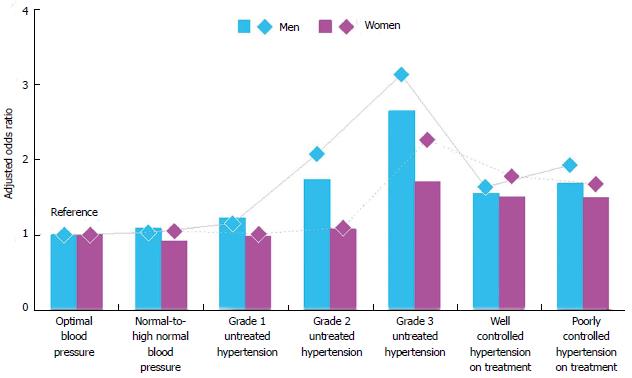Copyright
©2014 Baishideng Publishing Group Inc.
World J Cardiol. Jul 26, 2014; 6(7): 531-538
Published online Jul 26, 2014. doi: 10.4330/wjc.v6.i7.531
Published online Jul 26, 2014. doi: 10.4330/wjc.v6.i7.531
Figure 5 Adjusted odds ratios for two kinds of events over one year of follow-up in male and female Japanese medical insurance beneficiaries aged 40-54 years, grouped according to hypertension status.
The bars represent the risk of undergoing hospitalization for ≥ 14 cumulative days, while the diamonds represent the risk of falling into the top 1% group of medical expenditure. A logistic regression model was used to calculate odds ratios after adjustment for age, body mass index, smoking habit, serum low-density lipoprotein cholesterol, log-transformed fasting plasma glucose, and medications for hypercholesterolemia and diabetes, with the “optimal blood pressure” group acting as the reference. Male and female participants who fell into the sex-specific top 1% medical expenditure group each incurred ≥ 1571 euros/mo and ≥ 1249 euros/mo, respectively (1 euro = 95.91 Japanese yen). From Nakamura et al[11].
- Citation: Nakamura K, Okamura T, Miura K, Okayama A. Hypertension and medical expenditure in the Japanese population: Review of prospective studies. World J Cardiol 2014; 6(7): 531-538
- URL: https://www.wjgnet.com/1949-8462/full/v6/i7/531.htm
- DOI: https://dx.doi.org/10.4330/wjc.v6.i7.531









